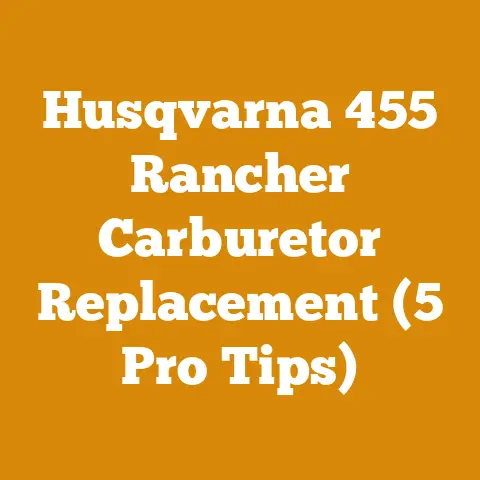Welding Log Splitter Wedge (4 Pro Tips for Durable Wings)
Aha!
The unmistakable clang of a log splitter wedge shearing off its wings.
I remember the first time it happened to me.
I was knee-deep in a mountain of oak, feeling like a firewood-splitting titan, when suddenly… ping!
The wing of my splitter wedge went flying, embedding itself harmlessly (thankfully!) in a nearby pile of woodchips.
That day, I learned a hard lesson: log splitter wedges, especially their wings, take an absolute beating.
Welding them back on is almost a rite of passage for anyone who processes a significant amount of wood.
But simply slapping some weld on isn’t enough.
You need a plan, the right techniques, and a good understanding of why those wings fail in the first place.
This guide is born from that experience, and countless hours of refining my welding techniques to create durable, long-lasting repairs.
I’m going to walk you through four pro tips that will dramatically improve the lifespan of your newly welded log splitter wedge wings.
Welding Log Splitter Wedge: 4 Pro Tips for Durable Wings
Log splitters are workhorses, and their wedges are the point of contact for all that force.
A broken wedge means downtime, and that translates to lost productivity, whether you’re a weekend warrior or a small-scale firewood business.
Understanding how to properly weld and reinforce those wings is a crucial skill.
Why Do Log Splitter Wedge Wings Fail?
Before we dive into the welding, let’s understand the enemy.
Wedge wings fail primarily due to:
- Metal Fatigue: Repeated stress from splitting logs causes microscopic cracks to form and grow over time.
This is exacerbated by the type of steel used in some wedges, which may not be ideal for the stresses involved. - Poor Weld Quality: The original welds on some wedges are simply inadequate.
They may be porous, lack penetration, or use the wrong type of welding rod. - Hardness Differentials: The base metal of the wedge and the weld metal may have different hardness levels.
This can create stress concentrations and lead to cracking at the weld interface. - Improper Use: Trying to split logs that are too large, knotty, or improperly positioned can put excessive strain on the wings.
- Material defects: Sometimes it’s simply a flaw in the metal itself.
Knowing these failure points allows us to address them proactively with our welding techniques.
Key Terms and Concepts
Let’s define some key terms to ensure we’re all on the same page:
- Log Splitter: A machine that uses hydraulic power to split logs.
There are gas-powered and electric models.
My personal preference is for gas-powered models in the 25-35 ton range for processing larger volumes of wood, as they offer better portability and power. - Wedge: The triangular piece of steel that does the actual splitting.
Wedges come in various shapes and sizes. - Wings: The angled extensions on the sides of the wedge that help to initiate the split.
These are the most vulnerable part of the wedge. - Weld Penetration: The depth to which the weld metal fuses with the base metal.
Good penetration is crucial for a strong weld. - Weld Porosity: The presence of small holes or voids within the weld metal.
Porosity weakens the weld. - Heat Affected Zone (HAZ): The area of base metal surrounding the weld that has been altered by the heat of welding.
The HAZ can be weaker than the base metal if not properly managed. - Preheating: Heating the base metal before welding to reduce the risk of cracking.
- Post-Weld Heat Treatment: Heating the weld after welding to relieve stress and improve toughness.
- Green Wood: Freshly cut wood with a high moisture content (often above 30%).
- Seasoned Wood: Wood that has been dried to a lower moisture content (typically below 20%).
Seasoned wood is easier to split and burns more efficiently.
I aim for around 15-18% moisture content for firewood.
Pro Tip #1: Preparation is Paramount
Before you even think about striking an arc, proper preparation is essential.
This isn’t just about cleaning the metal; it’s about setting yourself up for success.
Step 1: Thorough Cleaning:
- Use a wire brush, grinder with a wire wheel, or abrasive disc to remove all rust, scale, paint, and other contaminants from the wedge and the detached wing.
Pay particular attention to the areas where you will be welding.
Any contamination will lead to porosity and a weak weld. - I often use a flap disc on an angle grinder for this.
It’s aggressive enough to remove rust and scale, but gentle enough not to gouge the metal. - Pro Tip: If the wing has been broken for a while, there may be oil or grease soaked into the metal.
Clean the area thoroughly with a solvent like acetone or brake cleaner before grinding.
Welding over oil will create nasty fumes and a poor weld.
Step 2: Beveling the Edges:
- Use a grinder to create a bevel along the edges of both the wedge and the wing where they will be joined.
A 45-degree bevel is ideal.
This creates a V-shaped groove that allows for deeper weld penetration. - The bevel should extend about halfway through the thickness of the metal.
This ensures that the weld metal fully fuses with both pieces. - Why bevel? Without a bevel, the weld metal will simply sit on the surface, creating a weak bond.
The bevel allows the weld to penetrate deep into the metal, creating a much stronger connection. - Safety Note: Wear appropriate eye and face protection when grinding.
Metal shards can be incredibly dangerous.
Step 3: Fit-Up and Clamping:
- Carefully align the wing with the wedge.
Ensure that it is properly positioned and that there are no gaps between the pieces. - Use clamps or welding magnets to hold the wing in place.
This is crucial for maintaining proper alignment during welding. - Pro Tip: If the wing is slightly bent or distorted, use a hammer and anvil to straighten it before clamping.
A perfectly aligned wing will result in a stronger and more durable repair. - Case Study: I once had a wing that was significantly bent.
I tried to force it into place with clamps, but it kept popping out of alignment.
I finally took the time to straighten it with a hammer and anvil, and the resulting weld was much stronger and more reliable.
Step 4: Preheating (Critical for Some Metals):
- For thicker wedges (over 1/2 inch) or those made from high-carbon steel, preheating is essential to prevent cracking.
Use a propane torch or welding torch to heat the area around the weld to around 200-300°F (93-149°C). - Why preheat? Preheating reduces the temperature difference between the weld metal and the base metal, which minimizes stress and reduces the risk of cracking.
- How to check temperature: You can use a temperature crayon or infrared thermometer to ensure that you’ve reached the desired temperature.
- Caution: Be careful not to overheat the metal, as this can weaken it.
Pro Tip #2: Choosing the Right Welding Process and Consumables
The type of welding process and consumables you use will have a significant impact on the strength and durability of your repair.
Welding Processes:
- Stick Welding (SMAW): This is a versatile and relatively inexpensive process that is well-suited for welding thicker materials.
It’s what I often use for field repairs because it’s portable and doesn’t require shielding gas.- Pros: Portable, inexpensive, good for dirty or rusty metal.
- Cons: Can be difficult to learn, produces slag that must be removed, lower deposition rate than other processes.
- MIG Welding (GMAW): This is a faster and easier process than stick welding, but it requires shielding gas.
It’s a good choice for welding thinner materials and for making long, continuous welds.- Pros: Fast, easy to learn, produces clean welds.
- Cons: Requires shielding gas, not as good for dirty or rusty metal, can be more expensive than stick welding.
- Flux-Cored Arc Welding (FCAW): This process is similar to MIG welding, but it uses a flux-cored wire that provides its own shielding.
It’s a good choice for welding outdoors or in windy conditions.- Pros: Good for outdoor welding, high deposition rate.
- Cons: Produces slag, can be more expensive than MIG welding.
- TIG Welding (GTAW): This is the most precise and versatile welding process, but it’s also the most difficult to learn.
It’s a good choice for welding critical joints and for welding dissimilar metals.
I use TIG welding when I want the absolute strongest and cleanest weld, especially on higher-quality wedges.- Pros: Precise, versatile, produces very clean welds.
- Cons: Most difficult to learn, requires shielding gas, slow deposition rate.
Welding Rods/Wire:
- For Stick Welding:
- E7018: This is a low-hydrogen rod that is a good choice for welding high-strength steel.
It produces strong, ductile welds that are resistant to cracking.
I recommend this for most log splitter wedge repairs.
It requires a bit more skill to use than E6011, but the results are worth it. - E6011: This is a good general-purpose rod that is easy to use.
However, it produces welds that are not as strong or ductile as those made with E7018.
- E7018: This is a low-hydrogen rod that is a good choice for welding high-strength steel.
- For MIG Welding:
- ER70S-6: This is a common mild steel welding wire that is a good choice for most log splitter wedge repairs.
- For Flux-Cored Welding:
- E71T-1: This is a good general-purpose flux-cored wire that is suitable for welding mild steel.
My Recommendation:
For most DIYers, I recommend stick welding with E7018 or MIG welding with ER70S-6.
These processes are relatively easy to learn and provide good results.
If you’re an experienced welder, TIG welding with a suitable filler rod will give you the strongest and most precise weld.
Choosing the Right Amperage:
- The correct amperage setting will depend on the thickness of the metal and the type of welding rod or wire you are using.
Consult the manufacturer’s recommendations for the specific rod or wire you are using. - General Rule of Thumb: For stick welding, use about 1 amp per 0.001 inch of metal thickness.
For example, if you are welding 1/4 inch (0.250 inch) steel, use about 250 amps. - Too Low Amperage: Results in poor penetration and a weak weld.
The weld will look “cold” and will not be properly fused to the base metal. - Too High Amperage: Results in excessive spatter, burn-through, and a weakened heat-affected zone.
The weld will look “hot” and may have undercut (a groove melted into the base metal alongside the weld).
Pro Tip #3: Welding Technique for Maximum Strength
The way you weld is just as important as the materials you use.
Here’s how to lay down strong, durable welds on your log splitter wedge.
Step 1: Tack Welding:
- Before making the final weld, tack weld the wing in place at several points.
This will prevent it from moving during welding. - Place tack welds at each corner of the wing and in the middle of each side.
- Why tack weld? Tack welds hold the pieces in alignment and prevent distortion during the welding process.
Step 2: Welding Sequence:
- Use a series of short, overlapping welds to fill the V-shaped groove created by the bevel.
This technique, often called “staggered welding,” helps to distribute heat evenly and prevent distortion. - Important: Don’t try to weld the entire seam in one pass.
This will create excessive heat and increase the risk of cracking. - Welding Pattern: I prefer a weaving motion, moving the electrode or torch back and forth across the joint.
This helps to ensure good penetration and fusion. - Pro Tip: Overlap each weld pass by about 50%.
This ensures that there are no gaps or voids in the weld.
Step 3: Multi-Pass Welding:
- For thicker materials, you may need to make multiple passes to fill the groove completely.
Allow each pass to cool slightly before making the next pass. - Why multi-pass? Multi-pass welding allows you to build up the weld gradually, which reduces the amount of heat input and minimizes distortion.
- Cleaning Between Passes: Remove any slag or spatter between passes using a chipping hammer and wire brush.
This will ensure that the next pass properly fuses with the previous pass.
Step 4: Cooling:
- Allow the weld to cool slowly.
Do not quench it with water or air.
Rapid cooling can cause cracking. - Pro Tip: Cover the weld with a welding blanket or insulating material to slow the cooling process.
Common Welding Mistakes to Avoid:
- Porosity: Caused by contamination, improper shielding gas, or incorrect amperage.
- Lack of Penetration: Caused by insufficient amperage or improper welding technique.
- Undercut: A groove melted into the base metal alongside the weld.
Caused by excessive amperage or improper welding technique. - Cracking: Caused by rapid cooling, high-carbon steel, or improper welding technique.
Pro Tip #4: Reinforcement and Post-Weld Treatment
A good weld is a start, but reinforcing the wings and properly treating the weld after completion will dramatically increase their lifespan.
Step 1: Reinforcing the Wings:
- Adding Gussets: Cut small triangular pieces of steel plate and weld them to the sides of the wing, providing additional support.
Gussets act like braces, distributing the load and preventing the wing from flexing. - Pro Tip: Use thicker steel for the gussets than the wing itself.
This will provide even greater strength.
I typically use 1/4-inch steel plate for gussets on wings made from 3/16-inch steel. - Welding the Gussets: Weld the gussets to both the wing and the wedge using the same techniques described above.
Ensure that the gussets are fully welded and that there are no gaps or voids. - Creating a “Rib”: Weld a bead of weld metal along the top edge of the wing, creating a raised rib.
This rib will add stiffness and prevent the wing from bending. - Case Study: I had a customer who was constantly breaking the wings on his log splitter wedge.
I added gussets and a rib to the wings, and he hasn’t had a problem since.
He said the reinforced wings were noticeably stronger and more durable.
Step 2: Post-Weld Heat Treatment (PWHT):
- This is an optional step, but it can significantly improve the toughness and ductility of the weld.
PWHT involves heating the weld to a specific temperature and then allowing it to cool slowly. - Benefits of PWHT: Relieves stress in the weld, reduces the risk of cracking, improves toughness and ductility.
- How to Perform PWHT:
- Use a propane torch or welding torch to heat the weld to around 400-600°F (204-316°C).
- Hold the temperature for about one hour per inch of metal thickness.
- Allow the weld to cool slowly in still air.
- Caution: Be careful not to overheat the metal, as this can weaken it.
Step 3: Grinding and Finishing:
- Once the weld has cooled, use a grinder to smooth out any rough edges or imperfections.
This will improve the appearance of the weld and prevent it from catching on logs. - Pro Tip: Use a flap disc on an angle grinder for this.
It’s aggressive enough to remove material quickly, but gentle enough not to gouge the metal. - Painting: Apply a coat of paint to the weld to prevent rust.
Step 4: Ongoing Maintenance:
- Regularly inspect the wedge for cracks or other damage.
Repair any damage promptly to prevent it from worsening. - Keep the wedge sharp.
A dull wedge will require more force to split logs, which will put more stress on the wings. - Sharpening: Use a grinder to sharpen the leading edge of the wedge.
Be careful not to overheat the metal. - Lubrication: Apply a thin coat of oil or grease to the wedge to prevent rust and reduce friction.
Choosing the Right Wood for Your Splitter
The type of wood you’re splitting also impacts the lifespan of your wedge.
- Green Wood vs.
Seasoned Wood: Green wood is much harder to split than seasoned wood.
The high moisture content makes it more resistant to splitting.
Always try to split wood that has been seasoned for at least six months. - Knotty Wood: Knotty wood is notoriously difficult to split.
The knots create stress concentrations that can easily break the wings of your wedge.
Avoid splitting knotty wood if possible.
If you must split knotty wood, use a maul or sledgehammer to drive the wedge through the knot. - Hardwoods vs.
Softwoods: Hardwoods like oak, maple, and hickory are denser and more difficult to split than softwoods like pine, fir, and spruce.
If you’re splitting a lot of hardwoods, you may need to reinforce your wedge more frequently. - Wood Size: Don’t try to split logs that are too large for your splitter.
This will put excessive strain on the wedge and can cause it to break.
Strategic Advantages of a Well-Maintained Log Splitter
Investing time and effort in maintaining your log splitter, including properly welding and reinforcing the wedge, offers several strategic advantages:
- Reduced Downtime: A strong, durable wedge means fewer breakdowns and less time spent repairing your splitter.
This translates to more time spent splitting wood and less time wasted on maintenance. - Increased Productivity: A sharp, well-maintained wedge splits wood more efficiently, allowing you to process more wood in less time.
- Lower Operating Costs: A properly maintained splitter will last longer and require fewer repairs, reducing your overall operating costs.
- Improved Safety: A broken wedge can be dangerous.
Properly welding and reinforcing your wedge reduces the risk of injury. - Enhanced Resale Value: A well-maintained log splitter will command a higher resale value than one that has been neglected.
Costs, Materials, and Skill Levels
Here’s a breakdown of the costs, materials, and skill levels required for welding log splitter wedge wings:
Costs:
- Welding Machine: $200 – $2000 (depending on the type and quality)
- Welding Rods/Wire: $20 – $50 per spool/box
- Grinding Discs: $1 – $5 each
- Steel Plate (for gussets): $20 – $50 (depending on the size and thickness)
- Shielding Gas (for MIG/TIG): $30 – $50 per bottle
- Safety Gear: $50 – $100 (welding helmet, gloves, safety glasses)
Materials:
- Log Splitter Wedge
- Steel Plate (for gussets)
- Welding Rods/Wire
- Grinding Discs
- Paint
Skill Levels:
- Basic Welding Skills: Required for stick welding and MIG welding.
- Intermediate Welding Skills: Recommended for TIG welding.
- Grinding Skills: Required for preparing the metal and finishing the weld.
- Mechanical Aptitude: Helpful for understanding how the log splitter works and how to properly maintain it.
Practical Next Steps
Ready to tackle your own log splitter wedge repair?
Here’s a step-by-step guide to get you started:
- Assess the Damage: Carefully inspect the wedge and wing to determine the extent of the damage.
- Gather Your Materials and Tools: Make sure you have everything you need before you start.
- Prepare the Metal: Clean and bevel the edges of the wedge and wing.
- Choose Your Welding Process and Consumables: Select the appropriate welding process and consumables based on your skill level and the materials you are working with.
- Tack Weld the Wing in Place: Secure the wing to the wedge with tack welds.
- Weld the Wing: Use a series of short, overlapping welds to fill the groove.
- Reinforce the Wings: Add gussets or a rib to provide additional support.
- Post-Weld Heat Treatment (Optional): Heat the weld to relieve stress.
- Grind and Finish the Weld: Smooth out any rough edges and apply a coat of paint.
- Regularly Maintain the Wedge: Inspect the wedge for damage and keep it sharp.
Conclusion
Welding log splitter wedge wings is a skill that will save you time, money, and frustration.
By following these four pro tips, you can create durable, long-lasting repairs that will keep your log splitter running smoothly for years to come.
Remember, preparation is key, choose the right welding process and consumables, use proper welding techniques, and reinforce the wings for maximum strength.
Now, go forth and conquer that woodpile!
And remember, safety first!
Always wear appropriate safety gear when welding and grinding.






